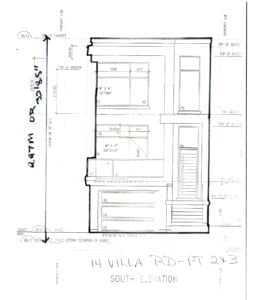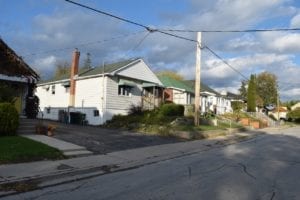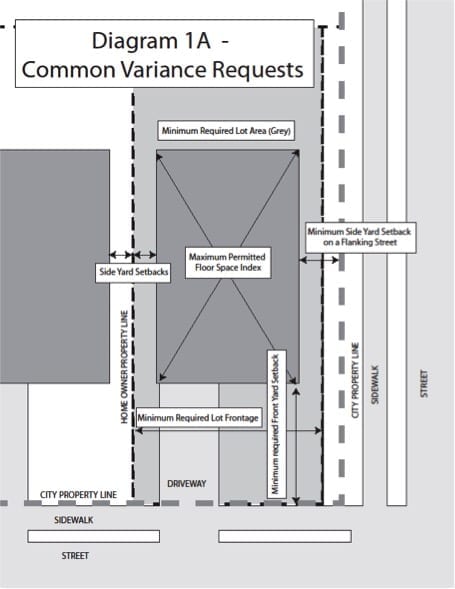If you receive a Notice from the Committee of Adjustment, here’s a Guide to the Notice

A drawing of one of the two, 3-storey buildings proposed for 14 Villa Road. Each building measures almost 33 feet tall at the front. Click on the image to enlarge it.
In the text that follows we refer specifically to the 14 Villa Road application. Residents elsewhere in Toronto will also find this overview useful.
A previous post, based on material from the Long Branch Neighbourhood Association, is entitled:
The latter post included links to two PDF files:
guide-to-the-public-hearing-notice-october-2016 – as it applies to 14 villa road – version 2
things-to-think-about-october-2016
In the current post, we have displayed the contents of the first of the two above-noted PDF files; in a second, separate post we will display the contents of the second of the two above-mentioned posts.
Guide to the Notice
*
I have received a Notice of a public hearing in the mail. What is it and what does it mean?
*
The basics
This notice is your invitation to have input about decisions being made about your neighbourhood.
If neighbours do not express concerns and the construction requests are approved, the proposed homes, as outlined, will be built.
The Committee making the decision considers silence from the neighbours to mean they support the application. If you have concerns, expressing them to this Committee is the only chance you have to act on them.
Here is helpful background:
The City Council in consultation with the City Planning Department lays out rules and guidelines for construction of buildings and homes in Toronto. These become formalized in Zoning By-laws. The Zoning Bylaws ensure that, in the opinion of our Planning Department, Toronto neighbourhoods remain attractive, habitable, places.
You have received the Notice of Public Hearing because the owner of the property is applying for exemptions to the City’s Zoning Bylaws, which include dividing the lot.

The white house on the left is 14 Villa Road, the property which a developer has proposed to sever into two, smaller lots. Jaan Pill photo. Click on the photo to enlarge it.
Their application needs to be made to the Committee of Adjustment. The deadline to submit letters is November 2, 2016. The actual meeting is at 5:00 pm on Thursday, November 3, 2016.
The material you have received will include 3 parts:
Public Hearing Notice – Consent: This is notice that the owner of the property is applying to sever or divide the property into two lots, both smaller than is recommended in the city bylaws.
Public Hearing Notice – Minor Variance/Permission: If there is a request for consent/severance, there will be two similar documents that list the exceptions to the City of Toronto Zoning Bylaws that are being requested by the builder. The two properties will be identified as Part 1 and Part 2.
Site Plan: On the Site Plan the two proposed homes will be labelled this way. The drawing will indicate where they are to be located on the property. The drawing should indicate their location in relation to the existing adjacent homes.
What the new home[s] will look like: This information is not generally part of the package. We have provided a rough idea for you in this package, but if you’d like to see more, you can obtain this information [and much more] by going online at the Committee of Adjustment’s Application Information Centre. You can also call or email the planning technician with any questions (contact info provided).
Specific measurements are very important to note as artist renderings in your package may not be to scale.
What do the requests for minor variance mean?
For each variance requested you are given several pieces of information:
- what the City’s 2013 Comprehensive Zoning By-Law supports
- in some cases a different number indicating what the Etobicoke Zoning Code allows*
- what the builder is requesting
* When amalgamation occurred in 1998 the new City of Toronto undertook to create a new Comprehensive Zoning By-law, which attempts to consolidate the regulations of all those individual municipalities to create city wide guidelines. These have not yet been approved and so in some sections both the proposed By-law and the By-law from the old municipality are provided.
Any or all of these variances may be requested:
Minimum required lot area is the square footage of a property. The city bylaw proposes the smallest size lot that can reasonably hold a house.
Minimum required lot frontage is the width of the lot fronting on the street. The city bylaw proposes the narrowest lot size that will maintain an attractive appearance in the neighbourhood.
Minimum front yard setback is the distance of the front of the house from the city property line. This may be a distance back from the sidewalk or curb or some other location on the property.
Maximum height is the measurement to the top peak of a house with a traditional roof. The city bylaw limits the tallest structure that will maintain a consistent and integrated look in a neighbourhood, assure privacy and allow light. Note: Builders often describe their proposed homes as being two storey, but the first floor starts over the garage so they are actually three storey buildings, which is why a height variance is required.
Maximum height for flat roofed dwelling is lower than for a peaked roof. It is important to be aware that if a height variance is requested for a flat roofed house the bulk of the house is even larger, as the top of the house is square shaped rather than triangular as for a traditional house.
Maximum permitted floor space index is a complicated term that refers to the amount of Floor space [excluding basement and garage] that will be on a lot relative to the amount of land it sits on. It basically refers to the mass of the house. The city bylaw proposes the largest mass of house that will maintain an attractive appearance in the neighbourhood.
Maximum first floor height above grade is the height at which the first floor, and the front door, start. The city bylaw limits the height of these in order to maintain continuity of line on the streetscape as well as ensure a sense of community [where neighbours meet ‘eye to ‘eye’].
Minimum required side yard setback is the distance between the side of the house and its property line. The city bylaw proposes the minimum distance that a house should be to its property line [and adjacent homes] to ensure privacy, access and an attractive appearance in the neighbourhood.
Minimum required side yard setback for eaves and other projections is the distance between the edge of eaves and other projection and the property line.
Minimum side yard setback on flanking street [corner lots only] is the distance between the edge of the house and the city property line [which may not be apparent].
Maximum floor area of auxiliary building is the areas of an additional separate structure, usually a garage.
Maximum garage wall height is the height of the wall, not including the roof.
If you prefer a visual representation, a chart [Diagram A] follows below.
Another translation you may need
The information is provided in meters so some may need a calculator to translate. Here is some help.
A metre is 39 inches, or 3.2 feet
A square metre is 10.76 square feet or 1.19 square yards.
[End of text, adapted from materials from Long Branch Neighbourhood Association]
*
Additional notes, regarding visualizations of proposed buildings
Also of relevance:
Please note: The Photoshop overlay for 9 Meaford (see link immediately above the sentence you are now reading) was criticized by the Chair of the Committee of Adjustment at the Sept. 29, 2016 Committee meeting at the Etobicoke Civic Centre. He said, in so many words, that an amateur rendering of what a new development will look like, when set against a photo of an existing streetscape, will lack credibility because there is no way to know that the measurements match, between the drawings and the photos.
A professional rendering, such as the 3D renderings for 14 Villa Road, is a step toward addressing such a concern.


I certainly do not support lot splitting but I feel that we have no real input.
The Committee of Adjustment may refuse the proposal of lot splitting but the the applicant will only carry it forward to the OMB and this is where we the people of the neighbourhood are stepped on without any consideration. This is a huge problem. Really frustrated with this process. Corner of James and 37th St. is a perfect example of this. It was originally (in 2012) decided by both CA and OMB not to allow lot splitting. Since then the house has been sold again, went through the process again, and now 2 new homes sit on the property thanks to the OMB. Seems that developers will get their way.
Good to read your message, Roman.
I agree. The situation we are facing is a huge problem.
The situation calls into question basic concepts – concepts such as the meaning of democracy, and the nature of a civil society in Canada come to mind.
In the circumstances, what can we do?
We can exercise such a level of human agency that is available to us, in the circumstances.
We can turn up at Committee of Adjustment meetings. We can write letters the Committee regarding particular cases, especially ones close to where we live. The unwritten law that appears to be in effect is that, from the Committee’s perspective, if no-one turns up at a hearing to express opposition, the Application goes sailing through.
From time to time, an Application is rejected by the Committee. Many such rejections are appealed, and are in a large proportion of cases accepted by the OMB.
What can we do, with regard to the OMB? We can support efforts, at the provincial level, to revise the legislation as it relates to OMB, so that decisions by Committees of Adjustment, or by municipal governments (e.g. with regard to Secondary Plans) are not overturned by the OMB.
Will the attempts to revise the OMB legislation lead to good results? Who knows?
In the meantime, we as residents can engage in networking, as we are doing through varied means, including through this website and many other social media venues.
As well, we can support – through our active participation – in efforts to get the Long Branch Neighbourhood Association up and running. Much good work has been done in setting into place the foundation for the association. A next step will involve setting up a board of directors and staging a general meeting of the association.
What else can we do as residents, to the extent that it may be possible in a civil society, assuming it is a civil society that we live in (assumptions being subject to error, of course)? We can support the next steps in the work of the team of people putting together the Long Branch Urban Design Guidelines Pilot Project.
The Long Branch Urban Planning Guidelines Pilot Project recommendations will be of much interest to residents and the Committee of Adjustment. The chair of the Committee said at the Sept. 29, 2016 Committee meeting that the Guidelines will provide some parameters for the Committee to follow.
Currently, decisions are highly subjective.
We have heard the Urban Design Guidelines are due early in 2017, but an anticipated Fall 2016 meeting of an advisory group, has not yet been held.
In the meantime, please do write a letter regarding the 14 Villa Application. Please turn up at the Committee of Adjustment meeting on Nov. 3, 2016 in support of the opposition to the 14 Villa application and similar applications.
We do not know what direction things will go in future. Quite a few people, that I know through my community self-orgaizing work in South Etobicoke in recent years, have moved away from Long Branch. The world is the limit, when a person moves away. Some move elsewhere in Canada. Some leave the country altogether. People who move, in response to what is happening here, bring a rich set of talents and enthusiasm to other communities, possibly to places where civil society truly has the opportunity to flourish.
For people who do not seek to move that far, I would suggest that it would be great to set up an expat community in Lakeview to the west of Long Branch. For many years, I’ve been reporting, at this website, about the more optimal conditions for a flourishing civil society that is in strong evidence in Lakeview and the City of Mississauga in general.
The City of Mississauga has a clearly defined Strategic Plan that is – amazing as this may sound – actually developed with broad input from Mississauga residents, and from what I can see (as a blogger, I make a point of observing such things as closely as I can), the Strategic Plan is actually in the process of being implemented.
As well, the governance and communications structures at the City of Mississauga appear to me to be of the highest quality. In fact, it has been the quality of the communications related to the Lakeview Waterfront Connection Project, the Small Arms re-purposing project, and similar Lakeview projects that originally alerted me to the great projects, with a great deal of citizen input, going on right now at the City of Mississauga.